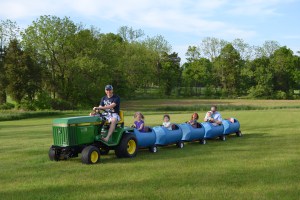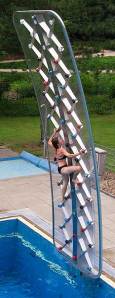Our Blog Has Moved!
Please check out our blog in it’s new location: http://www.wilkelaser.com/blog
Wilke Enginuity sells Barrel Trains to Rental Companies, Amusement Parks, Recreation Centers, and Campgrounds
Wilke Enginuity manufactures high quality plastic barrel trains for the amusement of kids and adults alike. You will find our barrel trains at many campgrounds, amusement parks, harvest festivals, and even restaurants throughout the U.S. These types of trains are also perfect for party rentals for any engagement: birthday parties, parades, summer picnics, or company events. You can even increase entertainment for the kids at recreation centers and day camps this summer.
While our customized plastic barrel trains can be made in many sizes to accommodate small children, they can also be manufactured in larger sizes in order to accommodate groups of adults; multiple trains are great for taking the whole gang on a ride! We can also adapt the trains to different propulsion systems. We have even made single trains for those individuals who want to attach to their own lawn mowers for personal use at home.
 Our customers love the precision we’ve put into each car-link. Each is fully compliant with all state regulations with the perfect blend of craftsmanship, simplicity of set-up, and ease of use. Our units are made of high quality plastic materials, making them lighter and safer than the commonly homemade version of the hollowed-out metal barrel.
Our customers love the precision we’ve put into each car-link. Each is fully compliant with all state regulations with the perfect blend of craftsmanship, simplicity of set-up, and ease of use. Our units are made of high quality plastic materials, making them lighter and safer than the commonly homemade version of the hollowed-out metal barrel.
Inquiries from rental companies, amusement parks, recreational centers and campgrounds are invited. For more information please email bjw@wilkelaer.com, call 1-800-936-6201, or visit our website www.wilkelaser.com.
Any Way You Slice It: Laser Cutting Vs. Other Industrial Cutting Methods
Wilke Enginuity has built its reputation on providing advanced CNC laser cutting and engraving services in a way that few other companies can equal, or even emulate. While we are fully confident in saying that laser cutting is your best overall bet when it comes to producing a quality cut, we wanted to acknowledge some of the other cutting methods out there on the market – and how they differ from the type of advanced laser cutting we provide here at Wilke. Finally, we want to talk about why we feel laser cutting is – all things considered – the safest and most reliable option in terms of getting a particular job done right, once and for all.
- Friction Sawing: This is a method practiced by many companies still in the world, one that uses high-speed rotary blades to cut through metal at a relatively quick place. But it’s gone out of favor with most serious North American manufacturing companies. Why? For a lot of reasons, but one of the foremost is that the wear-and-tear on blades can be cost-prohibitive in the long-run when compared to other, newer technologies.
- Shearing: This is still a widely-used method of cutting metal (steel in particular) in North America and is cost-effective to a large extent. One of the disadvantages of shearing – of manual shearing especially – is that it has a limited tolerance grade. If you want to cut more precisely through metals, laser cutting and plasma cutting are going to be better bets.
- Plasma Cutting: This is considered a relatively cost-effective means of cutting different types of ferrous and nonferrous metal with thicknesses ranging from gauge to 80 mm. While easy to use, fast-cutting, and reliably accurate, plasma cutters often need their electrodes and nozzles replaced, the costs of which can definitely add up over time. Also, plasma cutting doesn’t work on wood or plastic – which is its major drawback.
- Water-Jet Cutting: A method that’s prized for its high degree of accuracy, water-jet cutting is often used when cutting through materials like concrete, or materials that would otherwise get affected by the heat involved in the cutting process. While water-jet cutting can cut thickermaterials, non-conductive materials, and more, it’s much slower on the job when cutting the same kinds of materials that laser cutting is capable of.
- Laser Cutting: The advantages of laser cutting are considerable in comparison to other methods. Unlike other types of mechanical cutting, a piece of metal can be held in place much more easily when doing laser cutting. Furthermore, the cuts obtained are extremely precise – on par with plasma or some water-jet. The versatility of laser cutting and laser engraving is basically unparalleled: you can cut highly intricate designs into the surface. Finally, the range of materials that are workable via laser cutting is extremely wide: wood, rubber,carbon and stainless steel, and some plastics are all fair game when it comes to laser cutting.
Laser cutting provides a wide range of precise cutting capabilities in a large range of material thicknesses. Its range, its ease of operation, and its long-term cost savings make it a powerful tool in meeting your production goals in nearly any given material.
For more information on how our laser cutting services can impact your business for the better, contact us at Wilke today.
What Are the Best Materials and Thicknesses for Laser Cutting?
One of the many blessings of laser cutting – especially for those who have many years’ experience in the cutting method – is just how easily it can be applied to many different types of material. Few, if any, other cutting methods can measure up to laser cutting’s ability to handle ceramics, woods, rubber, some thermoplastics, and carbon and steel (to name the most general categories) at a high degree of tolerance. The fact is that Wilke has proved itself time and again in fabricating fine-tuned parts and components for a variety of industries using any of these materials. Whether using laser cutting to build birdhouses for the house and garden industry, or applying our technology to carbon steel to help manufacture parts for tractors, modern steel-frame buildings, and railway cars, we can pretty much make it happen given our long years of practice.
As far as goes thickness, a general rule of thumb for applying laser cutting is up to 1″ carbon steel, up to 5/8″ stainless steel, up to 1/2″ aluminum, up to 1 3/8″ acrilic and up to 1 1/2″ for wood and wood composites. While other means of cutting can cut thicker material than laser cutting, laser cutting covers a huge range of possible applications, to say the least. By effectively narrowing the spot size of the cutting point, a laser cutter’s sharpness can be increased enormously. Add to that the fact that by arranging the assist gas so that’s more intensively focused, you can cut more deeply by eliminating excess molten metal and other rubbish away from the kerf, and you’ve got yourself a powerful, “all-terrain” means of production.
At Wilke, our machinists and technicians are as finely-trained as their laser cutting and engraving instruments are accurate. For an even better sense of what Wilke Enginuity can do for your business, read some of our other entries in this blog, or consult our website.
Wilke Enginuity Supports Small Manufacturing Initiatives and Encourages You to Vote
 On the tail end of Manufacturing month we celebrate that manufacturing is coming back into prominence. There is constant conversation coming from both political parties about how important small businesses are to the American Economy and what each is going to do to stimulate that growth. We are happy to hear that both parties are talking about manufacturing being the backbone of and the future for growth in America. Both political parties agree that a strong American manufacturing base is a top priority. Additionally trends in the global market have favored the return of manufacturing jobs back to this country.
On the tail end of Manufacturing month we celebrate that manufacturing is coming back into prominence. There is constant conversation coming from both political parties about how important small businesses are to the American Economy and what each is going to do to stimulate that growth. We are happy to hear that both parties are talking about manufacturing being the backbone of and the future for growth in America. Both political parties agree that a strong American manufacturing base is a top priority. Additionally trends in the global market have favored the return of manufacturing jobs back to this country.
Wilke Enginuity encourages everyone to exercise your right to Vote.
Bringing Laser Precision Cutting to the Woodworking Industry
With summer well under way across the States, and with millions of Americans taking well-deserved summer vacations, it’s only natural that many want to take advantage of their free time to pursue favorite hobbies, crafts, and passions. One of the foremost of these hobbies happens to be bird watching. It’s estimated by the US Fish and Wildlife Service that some 51.3 million Americans spend upwards of $2.5 billion each year on observing birds of all varieties and species, both native and foreign. While a significant amount of that money is spent on ecological trips to various “bird-watching hotspots” throughout North America and abroad, a far larger sum is invested right at home – in the form of backyard birdhouses.
At Wilke, we make precision birdhouse components for a prominent company in the home and garden industry. Our client was receiving parts from another company, but wasn’t satisfied with the precision of the components delivered. The tolerance tightnesses were inconsistent to the point where they began searching for another manufacturer that would be able to deliver the goods as needed. They settled on Wilke Laser, and they had good reason to.
Our laser-cutting process is normally geared towards metals and alloys that require fine-tuned precision cutting and cornering. The metal components we build at Wilke go into anything from tractors, to trains, to architecture – all of which are fields where imprecise measurement is just not an option. Our customers can’t afford to make those kind of mistakes in their respective industries, and neither can we. The same principle can apply to woodworking just as in metallurgy. With Wilke at the helm, we’ve been able to consistently manufacture birdhouse components with tolerances down to a few thousandths of an inch of specifications. Our client, almost needless to say, is pleased with both our quality and consistency.
We’ve seen our fair share of rush-jobs over the years. Whether it’s an emergency quick-fix, or a significant-sized run that needs to be turned around in record-breaking time, we’re not exactly strangers to making sure we get the job done on the day it was stipulated, and not a minute after. It’s something that sets us apart from so many other shops out there… places that would rather doddle half the morning before turning to the work that needs doing. Our consistency keeps our customers loyal. They know they can depend on us to deliver precision goods in due order whenever necessity calls for it.
For example, there’s a maintenance company in our neck of Pennsylvania with strong ties to the snack-food industry. One of their main jobs is making sure the snack-food processing facilities in and around Hanover, PA are up and running with all systems. Needless to say, the vehicles and utility equipment they use on a daily basis in their line of work can take a steady drubbing in terms of wear-and-tear. It’s our job at Wilke to make sure their maintenance capabilities always stay afloat, ready at a minute’s notice for a quick, overnight repair job. They might jot down a sketch of a part they need for an application in two days’ time. It’s then our task to make sure this roughly-sketched part gets realized to the tee. Sure enough, we’ve never failed them yet; they keep coming back to us for more parts as needed.
Not only is our work outstanding, but it’s long-standing. Unlike other companies that can only make stopgap rush-jobs, our rush-jobs are built to last. It’s the combination of precision quality and speedy delivery that make Wilke stand out from its competitors. No, we’re not trying to win a race here, we’re just doing what we have to do to retain trusted relationships with our clientele. Necessity, as they say, is a great provider.
Getting Aboard the Future of Mass Transit
 The future of mass transit in America is up for grabs with competing visions of what such a network might entail. Proposals range from the $260 billion House-sponsored bill that would make our national rail network compete for federal funding with other transportation industries (rather than simply be granted an allotted fixed portion of funding), to the Senate bill, “Moving Ahead for Progress in the 21st Century,” that would allocate $109 billion for overall infrastructure spending over the next several years. While heated debate occurs on the floors of both respective branches of Congress, it’s becoming ever clearer that in order for our nation’s rail network to remain competitive on the international level, there needs to be an overarching vision that can win bipartisan support and traction enough to be signed into law. After all, the Chinese have bullet trains in and around Shanghai that can travel at nearly the speed of aircraft. Other countries have developed, or are in the process of developing, similar arrangements for transportation.
The future of mass transit in America is up for grabs with competing visions of what such a network might entail. Proposals range from the $260 billion House-sponsored bill that would make our national rail network compete for federal funding with other transportation industries (rather than simply be granted an allotted fixed portion of funding), to the Senate bill, “Moving Ahead for Progress in the 21st Century,” that would allocate $109 billion for overall infrastructure spending over the next several years. While heated debate occurs on the floors of both respective branches of Congress, it’s becoming ever clearer that in order for our nation’s rail network to remain competitive on the international level, there needs to be an overarching vision that can win bipartisan support and traction enough to be signed into law. After all, the Chinese have bullet trains in and around Shanghai that can travel at nearly the speed of aircraft. Other countries have developed, or are in the process of developing, similar arrangements for transportation.
Whatever the future of rail transport in this country, we know that we at Wilke can punch our weight when it comes to providing fabricated materials for trains. Not only are we experienced in prototyping rail-car parts, but we have extensive knowledge of actual, long-haul, long-run production of passenger train car parts. We can machine external parts for trains out of aluminum or stainless steel sheet, or we can build interior parts comprised predominantly of carbon steel. In addition, we offer coating and/or painting services as required.
At Wilke, we’re all aboard as far as getting America online – especially when it comes to the rail lines of the future.
 Summer is looking to gear up with a vengeance across the States. From Kennebunkport to Coronado Beach, tens of millions of Americans will hit the beaches along both coasts in a bid to escape the heat of June, July, and August. Fine and good, but what if the ocean isn’t an immediate option? What if you need someplace a little bit closer to home to keep cool during the summertime? Or what if you live in Arizona, or Kansas, or the Texas Pandhandle, and the sea is something of a thousand-mile drive in either direction?
Summer is looking to gear up with a vengeance across the States. From Kennebunkport to Coronado Beach, tens of millions of Americans will hit the beaches along both coasts in a bid to escape the heat of June, July, and August. Fine and good, but what if the ocean isn’t an immediate option? What if you need someplace a little bit closer to home to keep cool during the summertime? Or what if you live in Arizona, or Kansas, or the Texas Pandhandle, and the sea is something of a thousand-mile drive in either direction?
That’s where the time-honored tradition of public pools comes into play. Public swimming pools, their diving-boards and “deep ends,” their “Marcos” and their “Polos”: the image of the kid who cannonballs his way off the edge of the pool as he plugs his nose is just about as “American Summer” as you can get. Year after year, the concept never seems to play out or get old.
All the same, there are always new “twists” to the whole ritual of pool-diving. Almost every year, a new trend makes itself known. Recently, there’s been a nation-wide craze to incorporate climbing walls into swimming pools. The concept is both beautiful and simple: just as you would a climbing wall, you scamper vertically to the top of a “course” by using a series of fake rocks as hand-holds and foot-holds; and then – unlike a regular, hard-landing climbing wall – you let go and let yourself fall. With a swimming pool waiting at the end of that plunge, who isn’t ready to fall in love with the whole concept of a “swimming pool summer” all over again?
 It’s a great concept, and it’s already generated big business for aquatic amusement parks, hotels, public pools, and the like. Wilke is proud to have helped build poolside climbing walls for a new generation of summer-goers. The laser cutting and CNC machining that goes into our handiwork makes this sort of product affordable beyond just colleges, water-parks, and sports complexes. Made from stainless steel, each part of the wall fits seamlessly with the next, and gets easily incorporated into the superstructure of the building.
It’s a great concept, and it’s already generated big business for aquatic amusement parks, hotels, public pools, and the like. Wilke is proud to have helped build poolside climbing walls for a new generation of summer-goers. The laser cutting and CNC machining that goes into our handiwork makes this sort of product affordable beyond just colleges, water-parks, and sports complexes. Made from stainless steel, each part of the wall fits seamlessly with the next, and gets easily incorporated into the superstructure of the building.
Americans have a new friend for the hot months. Wilke is happy to make the introductions.
 It’s one heck of a good way to spend a summer afternoon, chugging along with your whole family aboard an easy-going barrel train. Unlike its fiercer cousin, the roller coaster, the barrel train is an activity that bodes well for everybody – not just screaming teen-agers. Young kids can get a thrill out of it, as can the old-timers. For anyone who hasn’t been on a miniature barrel train – whether it be at an amusement park, a theme restaurant, a state fair, or even on your own property – you’re missing out on one of the greatest, most easy-going leisure activities to roll America’s way since public swimming pools and miniature golf.
It’s one heck of a good way to spend a summer afternoon, chugging along with your whole family aboard an easy-going barrel train. Unlike its fiercer cousin, the roller coaster, the barrel train is an activity that bodes well for everybody – not just screaming teen-agers. Young kids can get a thrill out of it, as can the old-timers. For anyone who hasn’t been on a miniature barrel train – whether it be at an amusement park, a theme restaurant, a state fair, or even on your own property – you’re missing out on one of the greatest, most easy-going leisure activities to roll America’s way since public swimming pools and miniature golf.